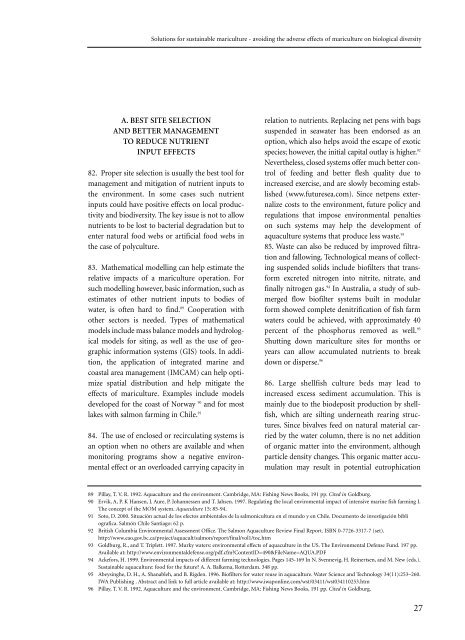Solutions for sustainable mariculture - Convention on Biological ...
Solutions for sustainable mariculture - Convention on Biological ...
Solutions for sustainable mariculture - Convention on Biological ...
- No tags were found...
You also want an ePaper? Increase the reach of your titles
YUMPU automatically turns print PDFs into web optimized ePapers that Google loves.
<str<strong>on</strong>g>Soluti<strong>on</strong>s</str<strong>on</strong>g> <str<strong>on</strong>g>for</str<strong>on</strong>g> <str<strong>on</strong>g>sustainable</str<strong>on</strong>g> <str<strong>on</strong>g>mariculture</str<strong>on</strong>g> - avoiding the adverse effects of <str<strong>on</strong>g>mariculture</str<strong>on</strong>g> <strong>on</strong> biological diversityA. BEST SITE SELECTIONAND BETTER MANAGEMENTTO REDUCE NUTRIENTINPUT EFFECTS82. Proper site selecti<strong>on</strong> is usually the best tool <str<strong>on</strong>g>for</str<strong>on</strong>g>management and mitigati<strong>on</strong> of nutrient inputs tothe envir<strong>on</strong>ment. In some cases such nutrientinputs could have positive effects <strong>on</strong> local productivityand biodiversity. The key issue is not to allownutrients to be lost to bacterial degradati<strong>on</strong> but toenter natural food webs or artificial food webs inthe case of polyculture.83. Mathematical modelling can help estimate therelative impacts of a <str<strong>on</strong>g>mariculture</str<strong>on</strong>g> operati<strong>on</strong>. Forsuch modelling however, basic in<str<strong>on</strong>g>for</str<strong>on</strong>g>mati<strong>on</strong>, such asestimates of other nutrient inputs to bodies ofwater, is often hard to find. 89 Cooperati<strong>on</strong> withother sectors is needed. Types of mathematicalmodels include mass balance models and hydrologicalmodels <str<strong>on</strong>g>for</str<strong>on</strong>g> siting, as well as the use of geographicin<str<strong>on</strong>g>for</str<strong>on</strong>g>mati<strong>on</strong> systems (GIS) tools. In additi<strong>on</strong>,the applicati<strong>on</strong> of integrated marine andcoastal area management (IMCAM) can help optimizespatial distributi<strong>on</strong> and help mitigate theeffects of <str<strong>on</strong>g>mariculture</str<strong>on</strong>g>. Examples include modelsdeveloped <str<strong>on</strong>g>for</str<strong>on</strong>g> the coast of Norway 90 and <str<strong>on</strong>g>for</str<strong>on</strong>g> mostlakes with salm<strong>on</strong> farming in Chile. 9184. The use of enclosed or recirculating systems isan opti<strong>on</strong> when no others are available and whenm<strong>on</strong>itoring programs show a negative envir<strong>on</strong>mentaleffect or an overloaded carrying capacity inrelati<strong>on</strong> to nutrients. Replacing net pens with bagssuspended in seawater has been endorsed as anopti<strong>on</strong>, which also helps avoid the escape of exoticspecies; however, the initial capital outlay is higher. 92Nevertheless, closed systems offer much better c<strong>on</strong>trolof feeding and better flesh quality due toincreased exercise, and are slowly becoming established(www.futuresea.com). Since netpens externalizecosts to the envir<strong>on</strong>ment, future policy andregulati<strong>on</strong>s that impose envir<strong>on</strong>mental penalties<strong>on</strong> such systems may help the development ofaquaculture systems that produce less waste. 9385. Waste can also be reduced by improved filtrati<strong>on</strong>and fallowing. Technological means of collectingsuspended solids include biofilters that trans<str<strong>on</strong>g>for</str<strong>on</strong>g>mexcreted nitrogen into nitrite, nitrate, andfinally nitrogen gas. 94 In Australia, a study of submergedflow biofilter systems built in modular<str<strong>on</strong>g>for</str<strong>on</strong>g>m showed complete denitrificati<strong>on</strong> of fish farmwaters could be achieved, with approximately 40percent of the phosphorus removed as well. 95Shutting down <str<strong>on</strong>g>mariculture</str<strong>on</strong>g> sites <str<strong>on</strong>g>for</str<strong>on</strong>g> m<strong>on</strong>ths oryears can allow accumulated nutrients to breakdown or disperse. 9686. Large shellfish culture beds may lead toincreased excess sediment accumulati<strong>on</strong>. This ismainly due to the biodeposit producti<strong>on</strong> by shellfish,which are silting underneath rearing structures.Since bivalves feed <strong>on</strong> natural material carriedby the water column, there is no net additi<strong>on</strong>of organic matter into the envir<strong>on</strong>ment, althoughparticle density changes. This organic matter accumulati<strong>on</strong>may result in potential eutrophicati<strong>on</strong>89 Pillay, T. V. R. 1992. Aquaculture and the envir<strong>on</strong>ment. Cambridge, MA: Fishing News Books, 191 pp. Cited in Goldburg.90 Ervik, A, P. K Hansen, J. Aure, P. Johannessen and T. Jahsen. 1997. Regulating the local enviromental impact of intensive marine fish farming I.The c<strong>on</strong>cept of the MOM system. Aquaculture 15: 85-94.91 Soto, D. 2000. Situación actual de los efectos ambientales de la salm<strong>on</strong>icultura en el mundo y en Chile. Documento de investigación bibliografica. Salmón Chile Santiago: 62 p.92 British Columbia Envir<strong>on</strong>mental Assessment Office. The Salm<strong>on</strong> Aquaculture Review Final Report. ISBN 0-7726-3317-7 (set).http://www.eao.gov.bc.ca/project/aquacult/salm<strong>on</strong>/report/final/vol1/toc.htm93 Goldburg, R., and T. Triplett. 1997. Murky waters: envir<strong>on</strong>mental effects of aquaculture in the US. The Envir<strong>on</strong>mental Defense Fund. 197 pp.Available at: http://www.envir<strong>on</strong>mentaldefense.org/pdf.cfm?C<strong>on</strong>tentID=490&FileName=AQUA.PDF94 Acke<str<strong>on</strong>g>for</str<strong>on</strong>g>s, H. 1999. Envir<strong>on</strong>mental impacts of different farming technologies. Pages 145-169 In N. Svennevig, H. Reinertsen, and M. New (eds.).Sustainable aquaculture: food <str<strong>on</strong>g>for</str<strong>on</strong>g> the future? A. A. Balkema, Rotterdam. 348 pp.95 Abeysinghe, D. H., A. Shanableh, and B. Rigden. 1996. Biofilters <str<strong>on</strong>g>for</str<strong>on</strong>g> water reuse in aquaculture. Water Science and Technology 34(11):253–260.IWA Publishing . Abstract and link to full article available at: http://www.iwap<strong>on</strong>line.com/wst/03411/wst034110253.htm96 Pillay, T. V. R. 1992. Aquaculture and the envir<strong>on</strong>ment. Cambridge, MA: Fishing News Books, 191 pp. Cited in Goldburg.27
















